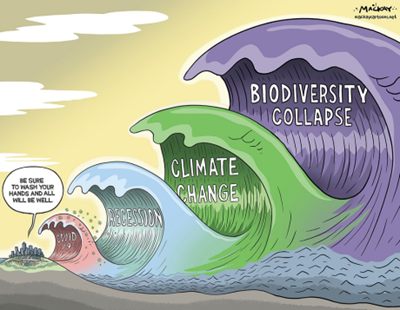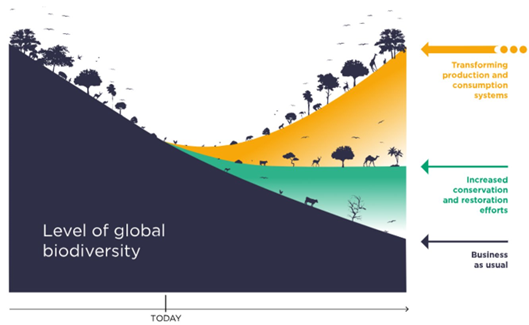No economy or business can survive without biodiversity.
The Earth’s diverse ecosystems are quite literally our life support network and have critical implications for humanity if left at the bottom of business’ to-do lists. Nature plays a critical role in providing the vast amounts of food, energy, medicines, resources, materials, and products which are woven into our global supply chains. Around $44 trillion of economic value (more than half of the world’s total GDP) is dependent on nature and its resources, making it exposed and highly vulnerable to risk.
Yet it is widely accepted that we are in a biodiversity crisis. Species extinction rates have accelerated exponentially in the last 150 years, with as many as one million species currently threatened by extinction. Needless to say, we also often overlook the effect biodiversity loss will have on humans. The current negative trends in biodiversity have the ability to undermine progress of the vast majority of the UN’s Sustainable Development Goals related to poverty, hunger, health, water, cities, climate, oceans, and land. Furthermore, if the world does not stay within the limit of 1.5°C of global warming, the consequential loss to biodiversity will drastically affect crop yields, alongside raw material availability.
The impacts of both climate change and biodiversity collapse on business’ supply chains will dwarf that of any pandemic or recession due to their inextricable reliance on our planet’s natural resources. All around the world, brands and retailers’ bottom lines are all tied to the fate of our natural world, yet it is those same businesses who have the biggest opportunity to prevent ecosystem collapse. And so the irony is, by not addressing and prioritising biodiversity accordingly, businesses are at risk themselves. Embedding biodiversity into strategy is less about ‘doing the right thing’ and is actually an existential necessity.
What causes biodiversity loss?
One of the main culprits of biodiversity loss (as well as a key driver of climate change) is the conversion of land for agriculture. This has caused 70% of global biodiversity loss to date. Monocropping and the use of pesticides also drastically reduces the soil quality, and variety of crops and pollinating insects. Deforestation directly leads to species loss when animals no longer have a habitat, cannot relocate, and therefore are driven to their limits. Businesses whose products rely upon the unsustainable conversion of land and its subsequent degradation are at risk of being perceived negatively by both consumers and investors, who are now favouring responsibly sourced products and more nature-aligned businesses.
But how do businesses become more nature-aligned and produce more responsibly sourced products whilst protecting both biodiversity and their bottom line?
How should businesses respond to the biodiversity crisis?
Many businesses are incorporating biodiversity policies, making more commitments to nature, and in some cases hiring biodiversity specialists. However, this still lags way behind climate; there are not enough businesses doing enough for global biodiversity.
Businesses need to make alignment to nature an integral part of strategy, with many already starting to rally around the Nature Positive movement. The goal of this global movement is to not just halt the negative impacts on nature, but reverse them, and is built upon the idea that widespread transformative action can contribute to nature recovery. Alongside this movement is the Taskforce on Nature-related Financial Disclosures (TNFD) and the Science-Based Targets for Nature (SBTN) initiative. The TNFD have developed a market-led, science-based framwork to help businesses integrate nature into their decision making. And in the same way that the Science-Based Target initiative (SBTi) combats emissions, the SBTN defines how businesses can assess, prioritise, measure, address and track their impacts and dependencies on natural ecosystems. It has three fundamental principles:
- To avoid and reduce pressure on nature loss
- To restore and regenerate ecosystems
- To transform underlying systems to address the drivers of nature loss.
Those businesses with large product portfolios and supply bases have a huge opportunity to affect positive change at scale. With the means to activate (and educate) thousands of suppliers around biodiversity and get them to take action, large retailers and brands in particular can drive positive action and catalytic change across the entire global supply chain. If these businesses do not take requisite action, unfortunately there will be only one outcome – a snowball trajectory of biodiversity decline. However, if commitments are made and followed through with transformative action and efforts to conserve and protect biodiversity, businesses and nature can not just coexist, but thrive.
A key part of this transformation will ultimately be not just making things ‘less worse’, but proactively helping nature recover through the financing and implementation of climate adaptation through nature based solutions.
What are nature-based solutions?
Nature-based solutions (NBS) are actions which protect, conserve, restore our planet’s ecosystems, species, and gene pools. They are inspired by the processes and functioning of nature whilst also producing societal, environmental, and economic benefits.
The values and benefits include:
- Increased food security from more resilient supply chains
- Cleaner air and water
- A reduction in risk from disaster
Essentially, the more diverse our planet’s ecosystems, the less susceptible they are to collapse and therefore the less risk businesses are exposed to from their supply chains.
The restoration of land and sustained management of biodiversity also happen to be some of the most effective ways of climate control, carbon storage, and keeping global heating below 1.5°C. According to the World Economic Forum, nature-based solutions can provide one-third of the climate mitigation required for the 1.5°C pathway.

For example, regenerative agriculture has the potential to transform portions of our commodity production systems into a carbon sink (a CO2 absorber). Alongside this ability to restore carbon and its high rank as one of the most impactful solutions for climate change, this method of agriculture also makes supply chains more resilient to climate instability. Other high-impact activities which promote biodiversity is peatland protection (such as those in the rainforests of Indonesia used for palm oil), tropical and temperate forest restoration, and silvopasture (the integration of livestock, forage, and trees).
The ill-fated pursuit of perfection
The focus of the conservation world has historically been and continues to be about measurement, knowledge generation, and perfection. This mentality has transgressed into the world of business, but instead comes in the form of confusion and inertia around biodiversity.
There is never going to be a perfect route set out ahead of us, and we cannot afford to wait for it to suddenly materialise without putting in the work. Failure to act on biodiversity as a business is no longer viable. The only way forward – for survival’s sake - is to collaborate with as many stakeholders as possible to gain a solid understanding of the role they play in the journey to becoming nature positive. For many businesses, this will involve engaging and activating all of their suppliers to adopt restorative and regenerative practices within the global supply chain.




